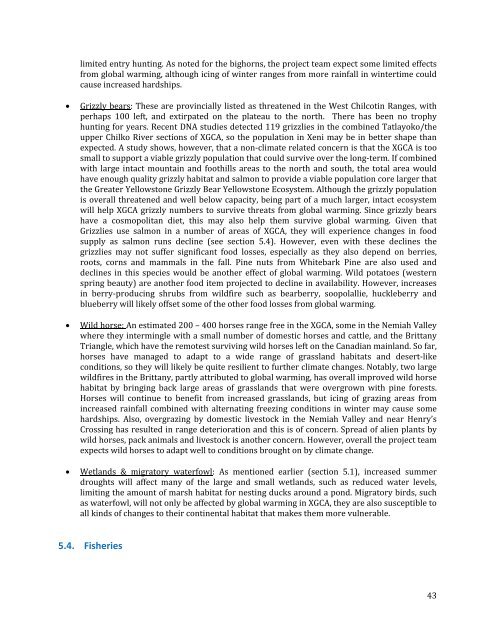From: on behalf of Panel Registry Subject: FW: TNG registration of ...
From: on behalf of Panel Registry Subject: FW: TNG registration of ...
From: on behalf of Panel Registry Subject: FW: TNG registration of ...
Create successful ePaper yourself
Turn your PDF publications into a flip-book with our unique Google optimized e-Paper software.
limited entry hunting. As noted for the bighorns, the project team expect some limited effects<br />
from global warming, although icing <strong>of</strong> winter ranges from more rainfall in wintertime could<br />
cause increased hardships.<br />
• Grizzly bears: These are provincially listed as threatened in the West Chilcotin Ranges, with<br />
perhaps 100 left, and extirpated <strong>on</strong> the plateau to the north. There has been no trophy<br />
hunting for years. Recent DNA studies detected 119 grizzlies in the combined Tatlayoko/the<br />
upper Chilko River secti<strong>on</strong>s <strong>of</strong> XGCA, so the populati<strong>on</strong> in Xeni may be in better shape than<br />
expected. A study shows, however, that a n<strong>on</strong>‐climate related c<strong>on</strong>cern is that the XGCA is too<br />
small to support a viable grizzly populati<strong>on</strong> that could survive over the l<strong>on</strong>g‐term. If combined<br />
with large intact mountain and foothills areas to the north and south, the total area would<br />
have enough quality grizzly habitat and salm<strong>on</strong> to provide a viable populati<strong>on</strong> core larger that<br />
the Greater Yellowst<strong>on</strong>e Grizzly Bear Yellowst<strong>on</strong>e Ecosystem. Although the grizzly populati<strong>on</strong><br />
is overall threatened and well below capacity, being part <strong>of</strong> a much larger, intact ecosystem<br />
will help XGCA grizzly numbers to survive threats from global warming. Since grizzly bears<br />
have a cosmopolitan diet, this may also help them survive global warming. Given that<br />
Grizzlies use salm<strong>on</strong> in a number <strong>of</strong> areas <strong>of</strong> XGCA, they will experience changes in food<br />
supply as salm<strong>on</strong> runs decline (see secti<strong>on</strong> 5.4). However, even with these declines the<br />
grizzlies may not suffer significant food losses, especially as they also depend <strong>on</strong> berries,<br />
roots, corns and mammals in the fall. Pine nuts from Whitebark Pine are also used and<br />
declines in this species would be another effect <strong>of</strong> global warming. Wild potatoes (western<br />
spring beauty) are another food item projected to decline in availability. However, increases<br />
in berry‐producing shrubs from wildfire such as bearberry, soopolallie, huckleberry and<br />
blueberry will likely <strong>of</strong>fset some <strong>of</strong> the other food losses from global warming.<br />
• Wild horse: An estimated 200 – 400 horses range free in the XGCA, some in the Nemiah Valley<br />
where they intermingle with a small number <strong>of</strong> domestic horses and cattle, and the Brittany<br />
Triangle, which have the remotest surviving wild horses left <strong>on</strong> the Canadian mainland. So far,<br />
horses have managed to adapt to a wide range <strong>of</strong> grassland habitats and desert‐like<br />
c<strong>on</strong>diti<strong>on</strong>s, so they will likely be quite resilient to further climate changes. Notably, two large<br />
wildfires in the Brittany, partly attributed to global warming, has overall improved wild horse<br />
habitat by bringing back large areas <strong>of</strong> grasslands that were overgrown with pine forests.<br />
Horses will c<strong>on</strong>tinue to benefit from increased grasslands, but icing <strong>of</strong> grazing areas from<br />
increased rainfall combined with alternating freezing c<strong>on</strong>diti<strong>on</strong>s in winter may cause some<br />
hardships. Also, overgrazing by domestic livestock in the Nemiah Valley and near Henry’s<br />
Crossing has resulted in range deteriorati<strong>on</strong> and this is <strong>of</strong> c<strong>on</strong>cern. Spread <strong>of</strong> alien plants by<br />
wild horses, pack animals and livestock is another c<strong>on</strong>cern. However, overall the project team<br />
expects wild horses to adapt well to c<strong>on</strong>diti<strong>on</strong>s<br />
brought <strong>on</strong> by climate change.<br />
• Wetlands & migratory waterfowl: As menti<strong>on</strong>ed earlier (secti<strong>on</strong> 5.1), increased summer<br />
droughts will affect many <strong>of</strong> the large and small wetlands, such as reduced water levels,<br />
limiting the amount <strong>of</strong> marsh habitat for nesting ducks around a p<strong>on</strong>d. Migratory birds, such<br />
as waterfowl, will not <strong>on</strong>ly be affected by global warming in XGCA, they are also susceptible to<br />
all kinds <strong>of</strong> changes to their c<strong>on</strong>tinental habitat that makes them more vulnerable.<br />
5.4.<br />
Fisheries<br />
43
















